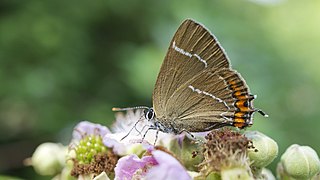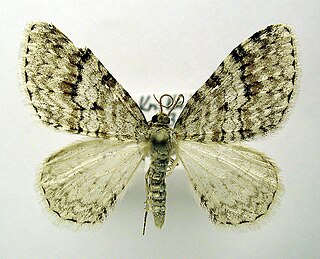
Butterflies are insects in the macrolepidopteran clade Rhopalocera from the order Lepidoptera, which also includes moths. Adult butterflies have large, often brightly coloured wings, and conspicuous, fluttering flight. The group comprises the large superfamily Papilionoidea, which contains at least one former group, the skippers, and the most recent analyses suggest it also contains the moth-butterflies. Butterfly fossils date to the Paleocene, about 56 million years ago.

Lepidoptera is an order of insects that includes butterflies and moths. About 180,000 species of the Lepidoptera are described, in 126 families and 46 superfamilies, 10 percent of the total described species of living organisms. It is one of the most widespread and widely recognizable insect orders in the world. The Lepidoptera show many variations of the basic body structure that have evolved to gain advantages in lifestyle and distribution. Recent estimates suggest the order may have more species than earlier thought, and is among the four most speciose orders, along with the Hymenoptera, Diptera, and Coleoptera.

The cinnabar moth is a brightly coloured arctiid moth found as a native species in Europe and western and central Asia then east across the Palearctic to Siberia to China. It has been introduced into New Zealand, Australia and North America to control ragwort, on which its larvae feed. The moth is named after the red mineral cinnabar because of the red patches on its predominantly black wings. The species was first described by Carl Linnaeus in his 1758 10th edition of Systema Naturae. Cinnabar moths are about 20 mm (0.79 in) long and have a wingspan of 32–42 mm (1.3–1.7 in).

The latticed heath is a moth of the family Geometridae, belonging to the subfamily Ennominae, placed in the tribe Macariini. The genus was erected by Carl Linnaeus in his 1758 10th edition of Systema Naturae.

The yellow-tail, goldtail moth or swan moth is a moth of the family Erebidae. The species was first described by Johann Kaspar Füssli in 1775, and has commonly been placed within the related genus Euproctis. It is distributed throughout Europe to the Urals, then east across the Palearctic to Siberia and south to India and Sri Lanka.

The white-letter hairstreak is a butterfly in the family Lycaenidae.

The dun-bar is a moth of the family Noctuidae. It is a common Palearctic species.

Ceratomia amyntor, the elm sphinx or four-horned sphinx, is a North American moth in the family Sphingidae. The species was first described by Carl Geyer in 1835. It has a wingspan of 3+1⁄4-4+1⁄2 inches. As the name suggests, the larvae (caterpillars) feed on elm trees (Ulmus), but they can also be found feeding on birch (Betula), basswood (Tilia), and cherry (Prunus). When the caterpillars are ready, they crawl to the bottom of the host tree, where they crawl underneath the soil and pupate and may overwinter underground if late enough into the year. Vegetable growers should be aware of this larvae due to its insatiable appetite. One of these larvae are capable in devouring huge amounts of plant's foliage and even succulent stems.

Cleaves Wood is a 40.38 hectare biological Site of Special Scientific Interest (SSSI) near the village of Wellow in Bath and North East Somerset, notified in 1988.
Ulmus glabra 'Cebennensis', also known as the Cevennes Elm, is a cultivar of the Wych Elm. The first known publication of the cultivar epithet was in the 1831-1832 catalogue from the Audibert brothers plant nursery at Tonelle, near Tarascon in France. The cultivar was given the name Ulmus campestris var. cebennensis.

Hemaris tityus, the narrow-bordered bee hawk-moth, is a moth of the family Sphingidae which is native to the Palearctic.

Acronicta rumicis, the knot grass moth, is a species of moth which is part of the genus Acronicta and family Noctuidae. It was first described by Carl Linnaeus in his 1758 10th edition of Systema Naturae. It is found in the Palearctic region. A. rumicis lives and feeds on plants located in wide-open areas. At its larval stage, as a caterpillar, it causes such a large impact as a crop pest that it has received much attention and research. A. rumicis feeds on maize, strawberries and other herbaceous plants.

Epargyreus clarus, the silver-spotted skipper, is a butterfly of the family Hesperiidae. It is claimed to be the most recognized skipper in North America. E. clarus occurs in fields, gardens, and at forest edges and ranges from southern Canada throughout most of the United States to northern Mexico, but is absent in the Great Basin and western Texas.

Abraxas sylvata, the clouded magpie, is a Palearctic moth of the family Geometridae that was named by Giovanni Antonio Scopoli in 1763.

Biston strataria, the oak beauty, is a moth of the family Geometridae. It is native to Europe, the Balkan countries and the Black Sea region as far as Asia Minor and the Caucasus. The species was first described by Johann Siegfried Hufnagel in 1767. B. strataria is found in a variety of habitats, but is mostly found in woodlands where it rests on the bark of trees, camouflaged by its mottled black and grey wings. The male has feather-like antennae while those of the female are more thread-like. The moth has a wingspan of 40 to 56 mm.

Pyralis pictalis, the painted meal moth or poplar pyralis, is a snout moth. It is closely related to the family's type species the meal moth and consequently belongs to the tribe Pyralini of the snout moth subfamily Pyralinae. Its native range is tropical Asia to East Asia and to Wallacea and adjacent regions, but it has been quite widely distributed by humans. The term "Poplar" in its common name does not refer to the trees, but to Poplar, London, where the type specimen – from such an introduction – was caught. It was called scarce meal moth in the original description, which is only correct for the fringes of its range however.

Venusia cambrica, the Welsh wave, is a moth of the family Geometridae. It is found in Europe, western and central Siberia, Altai, Transbaikalia, the Russian Far East, the Korean Peninsula, Japan and in North America, where it can be found across Canada from Newfoundland and Labrador to British Columbia, south in the west to California, south in the east to Georgia.
Gynaephora rossii, in English known as Ross' tussock moth, is a species of tussock moth in the family Erebidae. It is widespread in the tundras and highlands of the Holarctic. It has large, furry caterpillars which seem to eat mostly saxifrages.


















